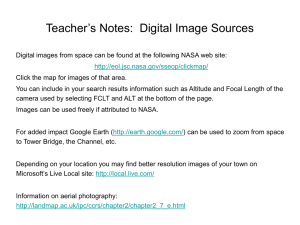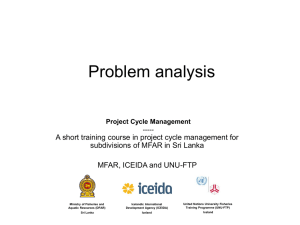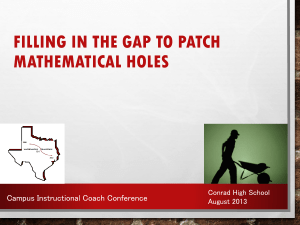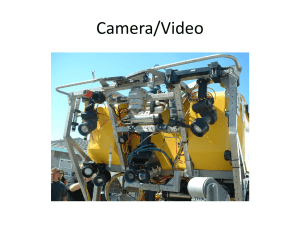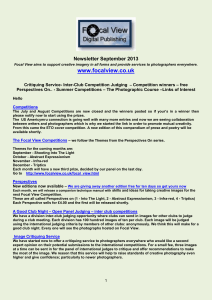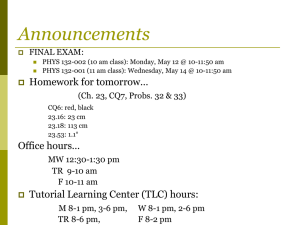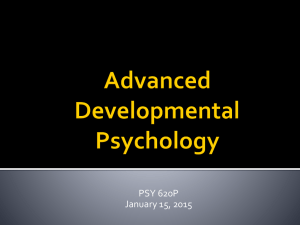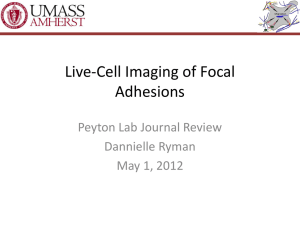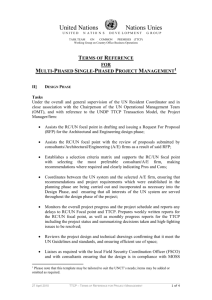Converging Lens
advertisement
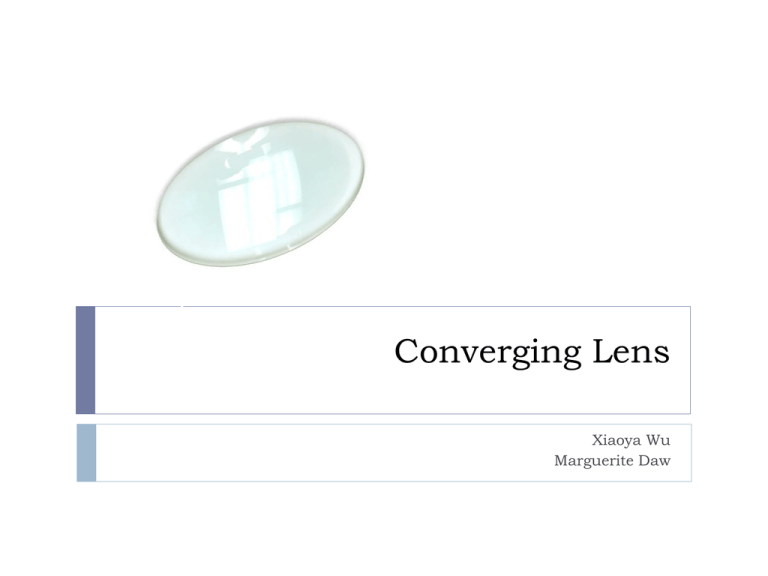
Converging Lens Xiaoya Wu Marguerite Daw Purpose Examine object the relationship between: distance vs. image distance object height vs. image height image height vs. object distance Hypothesis As object distance increases, image distance decreases As object height increases, image height increases As object distance increase, image height decrease Materials Lamp Marked track Lens Screen Object Flashlights Dark Room Ring stand Clamps Cardboard (for when small screen is too small for part 2) Setup Procedure (Part One) 1. 2. 3. 4. 5. 6. 7. 8. Measure the focal length by holding the lens and screen (mounted on the track) up to a distant image. Find the distance where the image is the most focused. Set up the stationary lamp at the zero mark of the track. Use ring stand and clamps to fix the lamp. Make sure to measure the height of the object on the lamp. Lay out the tracks and affix the lens at a distance of 15 focal distance away from the lamp/zero mark. Move the screen until a focused image is formed. Measure the image distance and height. Decrease the object distance by moving the lens closer to the lamp by 1 focal distance. Repeat 4. When object is 3 focal length away, decrease the object distance by 5.0 cm. When object is close to 2 focal length away, decrease the object distance by 2.0 cm. Stop when image gets too big to measure on the screen Data Table Constants: Image Height (L)= 1.9 cm Focal Length = 19.7 cm Method 1 -Both Asymptotes Method II -One Asymptote Since the last three points were very difficult to focus, we decided to leave them off. Mathematical Analysis Slope Significance/Model Error Calculations Constants: focal length = 19.7 cm Y-intercept Mathematical Analysis What does this mean? Looking at the intercept, we noticed that the x- and yintercepts are very close to being the same. Also the slope of the graph is -1. This suggests that the sum of 1/Image Distance and 1/Object Distance is a constant, which is 1/Focal Length. Thus, Error Calculations Constants: focal length = 19.7 cm Slope Experimental Value = -1.05 Actual Value = -1.00 Absolute Error =|-1.00 - -1.05| = .05 Relative Error =.05/-1.00 = .05 =5% Y-intercept Experimental Value =.0509 (1/cm) Actual Value = 1/19.7 cm = .0508 (1/cm) Absolute Error =|.0508 (1/cm) - .0509 (1/cm) | =.0001 (1/cm) Relative Error =.0001 (1/cm) / .0508 (1/cm) = .002 = .2% The last few points were left out because their image heights were not accurate due to difficulties in focusing. Mathematical Analysis Error Analysis Constants: Image Height = 1.90 cm Focal Length = 19.7 cm Procedure (Part Two) 1. 2. 3. 4. 5. Set up the lens at 1.5 focal length from the lamp. Measure the height of the object. Place the object in from of the lamp. Adjust the cardboard screen until the image is focused. Measure the image height. Repeat with objects with different heights. Repeat 1-4 at 2.5 focal length. Data Table Mathematical Analysis 1.5 Focal Length 2.5 Focal Length What Just Happened? Do = 1.5f Do = 2.5f Error Analysis 1.5 Focal Length Experimental Value = 2.02 Actual Value = 2.00 Absolute Error 2.5 Focal Length =|2.00 – 2.02| = .02 Relative Error = .02/2.00 = .01 = 1% Experimental Value = .604 Actual Value = .500 Absolute Error = |.500 = .604| = .104 Relative Error = .104 / .500 = .208 = 20.8% Source of Error The main source of error was measuring the image height. It was especially difficult when the image was small. For the first few points, there was no discernible difference in the height. The ruler was also not always held steady when measuring. Another source was getting the image completely focused and then measuring the image distance. At some points the distance could have been a range of values of + or – 1cm. Ray Diagram 2F F F 2F Ray Diagram 2F F F 2F Ray Diagram 2F F F 2F Ray Diagram 2F F F 2F Ray Diagram 2F F F 2F Thank you The End
